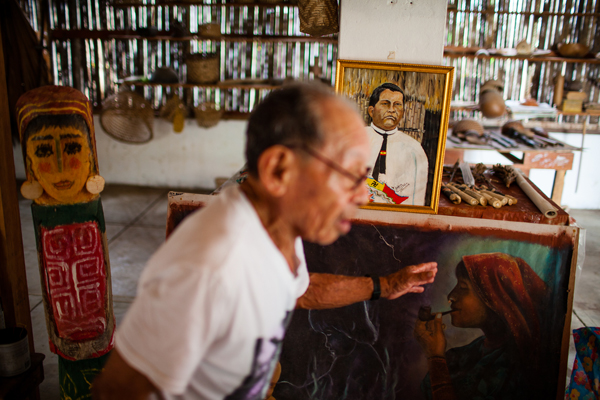Between the Forest and the Sea: Passing Down Traditions
Part I of this series: Life & Climate Change in Guna Yala
Part II of this series: The Yarsuisuit Collective
In 1925, Nele Kantule led a revolution that would make Guna Yala an independent and sovereign indigenous territory within Panama. Since then, the Guna have maintained a way of life that has allowed them to preserve their natural resources and mainland forest to an exceptional degree.
But today, like many indigenous groups around the world, the Guna face some of their greatest challenges yet: the impacts of climate change, encroaching outside influences, and a younger generation that many elders feel is drifting from its roots.
In response, Kantule’s octogenarian grandson, Jesus Smith, is doing his part to ensure that the Guna’s customs are not lost.
Between the Forest and the Sea, Pt. 3: Passing Down Traditions from roberto (bear) guerra on Vimeo.
OTHER PHOTOS BY ROBERTO (BEAR) GUERRA

The Kuna’s mainland forest as seen from the air in July 2014. Photo by Roberto (Bear) Guerra.

A young boy listens as a fellow student asks a question during Don Jesús’ weekly class about Kuna history, myth, and cultural traditions. Photo credit: Bear Guerra.

Don Jesús Smith stands in front of a painting of his grandfather, Kuna revolutionary hero Nele Kantule, while talking to students about artifacts in the Olomaili Museum on Ustupu Island. Photo credit: Bear Guerra.
Related articles
Between the Forest and the Sea: The Yarsuisuit Collective – Part II

(10/31/2014) In this multimedia piece by SRI fellow Bear Guerra, we follow Andrés de León and the Yarsuisuit collective, a group of men who grow and harvest food sustainably in the Guna mainland forest. They also run a store on the island of Ustupu that helps support their families, serving as a model for the wider community.
Between the forest and the sea: life and climate change in Guna Yala – Part I

(10/27/2014) The island-dwelling Guna people of Panama are one of the most sovereign indigenous communities in the world, but now severe weather and sea level rise are causing regular flooding on many of the islands, and will likely force the Guna to have to abandon their island homes for the mainland. This multimedia piece offers an introduction to everyday life and customs in Guna Yala and touches upon the uncertain future the Guna are now facing thanks to the impacts of climate change.
Balu Wala, or the Kuna ‘good life’: how one indigenous tribe is passing on its traditions (photos)

(10/03/2014) Jesús Smith is sitting at his old wooden desk facing the entrance to his house. He’s hunched over, shirtless, and wearing his chunky reading glasses while writing copious notes by hand — a favorite pastime. When he sees the profile of one of his students, Julio, walking past his doorway, he yells, ‘Hey! I’ll see you in class tomorrow!’
REDD+ versus indigenous people? Why a tribe in Panama rejected pay for their carbon-rich forests

(09/04/2014) There isn’t a word or phrase in the Kuna language for “carbon trading,” and much less for something as complex as REDD+. Standing for Reducing Emissions from Deforestation and Degradation, REDD+ is the worldwide UN-backed climate change mitigation scheme that relies on carbon trading within forest landscapes to fund forest conservation programs. And yet, since 2008, the Kuna people have been hearing lots about it and referring to it often in their private conversations.













